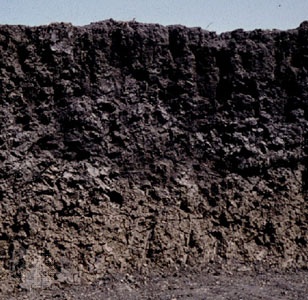Vertisol
FAO soil group
 one of the 30 soil groups in the classification system of the Food and Agriculture Organization (FAO) (soil). Vertisols are characterized by a clay-size-particle content of 30 percent or more by mass in all horizons (horizon) (layers) of the upper half-metre of the soil profile, by cracks at least 1 cm (0.4 inch) wide extending downward from the land surface, and by evidence of strong vertical mixing of the soil particles over many periods of wetting and drying. They are found typically on level or mildly sloping topography in climatic zones that have distinct wet and dry seasons. Vertisols contain high levels of plant nutrients, but, owing to their high clay content, they are not well suited to cultivation without painstaking management. They are estimated to occupy about 2.7 percent of the continental land area on Earth, mainly in the Deccan Plateau of India, the Al-Jazīrah region of The Sudan, eastern Australia, Texas in the United States, and the Paraná basin of South America.
one of the 30 soil groups in the classification system of the Food and Agriculture Organization (FAO) (soil). Vertisols are characterized by a clay-size-particle content of 30 percent or more by mass in all horizons (horizon) (layers) of the upper half-metre of the soil profile, by cracks at least 1 cm (0.4 inch) wide extending downward from the land surface, and by evidence of strong vertical mixing of the soil particles over many periods of wetting and drying. They are found typically on level or mildly sloping topography in climatic zones that have distinct wet and dry seasons. Vertisols contain high levels of plant nutrients, but, owing to their high clay content, they are not well suited to cultivation without painstaking management. They are estimated to occupy about 2.7 percent of the continental land area on Earth, mainly in the Deccan Plateau of India, the Al-Jazīrah region of The Sudan, eastern Australia, Texas in the United States, and the Paraná basin of South America.Vertisols are dark-coloured soils (though they have only moderate humus content) that may also be characterized by salinity and well-defined layers of calcium carbonate or gypsum. They are similar in all respects to the Vertisol order of the U.S. Soil Taxonomy.
United States soil order
 one of the 12 soil orders in the U.S. Soil Taxonomy (soil). Vertisols are clay (clay mineral)-rich soils that undergo significant vertical cracking during the dry seasons. Typically forming under grassland vegetation in basin or rolling hill landscapes, they are best suited for use as pastureland and for the cultivation of plants, such as rice, that thrive in standing surface water. Their very low water permeability when wet and unstable structure make them unsuitable for most other commercial uses. Although broadly distributed on every nonpolar continent, they occupy just over 2 percent of the land area on Earth, primarily in subtropical or tropical zones of Australia, India, and Africa and in parts of the western United States (California and Texas) and Europe (Austria and the Balkans).
one of the 12 soil orders in the U.S. Soil Taxonomy (soil). Vertisols are clay (clay mineral)-rich soils that undergo significant vertical cracking during the dry seasons. Typically forming under grassland vegetation in basin or rolling hill landscapes, they are best suited for use as pastureland and for the cultivation of plants, such as rice, that thrive in standing surface water. Their very low water permeability when wet and unstable structure make them unsuitable for most other commercial uses. Although broadly distributed on every nonpolar continent, they occupy just over 2 percent of the land area on Earth, primarily in subtropical or tropical zones of Australia, India, and Africa and in parts of the western United States (California and Texas) and Europe (Austria and the Balkans).Vertisols are characterized by a content of 30 percent or more by mass of clay-size particles throughout the upper half-metre (1.6 feet) of the soil profile, by centimetre-size (0.4-inch) cracks open to the land surface during the dry season, and by distinct evidence of strong vertical mixing of the soil particles through shrinking and swelling processes accompanying drying and rewetting periods. A definite annual dry season and a parent material conducive to alkaline pH and to the formation of swelling smectite-type clay minerals are believed to be essential to the development of these soils. The topographic setting for Vertisols usually has a crumpled look created by a complex array of mounds and depressions known as gilgai microrelief—the direct result of shrink-swell cycles over long periods of time.
- John Cabot
- John Cage
- John Caird
- John Caius
- John Callcott Horsley
- John Calvin
- John Cam Hobhouse, Baron Broughton
- John Cam Hobhouse Broughton, Baron
- John Campbell, 1st earl of Breadalbane and Holland
- John Campbell Breadalbane and Holland, 1st earl of
- John Canton
- John Capgrave
- John Carradine
- John Carroll
- John Carroll University
- John Cartwright
- John Carver
- John Cassavetes
- John Catron
- John C Breckinridge
- John C Calhoun
- John Ceiriog Hughes
- John C Frémont
- John C. Garand
- John Chalkhill